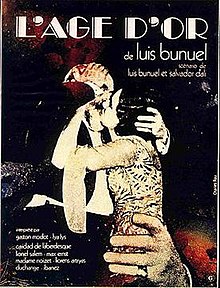L'Âge d'Or
| L'Age d'Or | |
|---|---|

Cinema poster for L'Age d'Or
|
|
| Directed by | Luis Buñuel |
| Produced by |
Vicomte Charles de Noailles Marie-Laure de Noailles |
| Written by | Luis Buñuel Salvador Dalí |
| Starring |
Gaston Modot Lya Lys Caridad de Laberdesque Lionel Salem Max Ernst Germaine Noizet Josep Llorens Artigas Duchange Ibanez |
| Music by | Luis Buñuel Georges van Parys |
| Cinematography | Albert Duverger |
| Edited by | Luis Buñuel |
| Distributed by | Corinth Films (1979 U.S. release) |
|
Release date
|
29 November 1930 |
|
Running time
|
63 minutes |
| Country | France |
| Language | French |
| Budget | 1 million francs |
L'Age d'Or (French: L'Âge d'Or, pronounced: [lɑʒ dɔʁ]), commonly translated as The Golden Age or Age of Gold, is a 1930 French surrealist comedy directed by Luis Buñuel about the insanities of modern life, the hypocrisy of the sexual mores of bourgeois society and the value system of the Roman Catholic Church. The screenplay is by Salvador Dalí and Buñuel.L'Age d'Or was one of the first sound films made in France, along with Prix de Beauté and Under the Roofs of Paris.
In a series of thematically-linked vignettes, a couple's attempts at fulfilling and consummating their romantic relationship are continually thwarted by the bourgeois values and sexual mores of family, church, and society. In the course of seeking sexual release and satisfaction, involving the man imagining an advertisement has come to life of a woman's hand rubbing herself, then later she tells her mother she hurt her finger, then a waiter at a party rubs a wine bottle in a similar fashion and the woman sublimates her sexual passion by fellating the toe of a religious statue before finally French kissing the conductor of the party's hired orchestra. The man's penchant for committing social taboos, like making love in the mud during a religious ceremony and slapping her mother, seems to excite the woman. He stumbles away from the father and daughter kiss to her bedroom where he throws a burning tree, a bishop, a plow, the bishop's staff, a giraffe statue and handfuls of pillow feathers out the window.
The final vignette is an allusion to the Marquis de Sade's novel 120 Days of Sodom; the intertitle reads: 120 Days of Depraved Acts, about an orgy in a castle, wherein the surviving orgiasts are ready to emerge to the light of mainstream society. From the castle door emerges the bearded and berobed Duc de Blangis (a character from de Sade's novel) who greatly resembles Jesus, the Christ, who comforts a young woman who has run out from the castle, before he takes her back inside. Afterwards, a woman's scream is heard, and only the Duc re-emerges; and he is beardless. The concluding image is a crucifix festooned with the scalps of women; to the accompaniment of jovial music, the scalps sway in the wind.
...
Wikipedia
